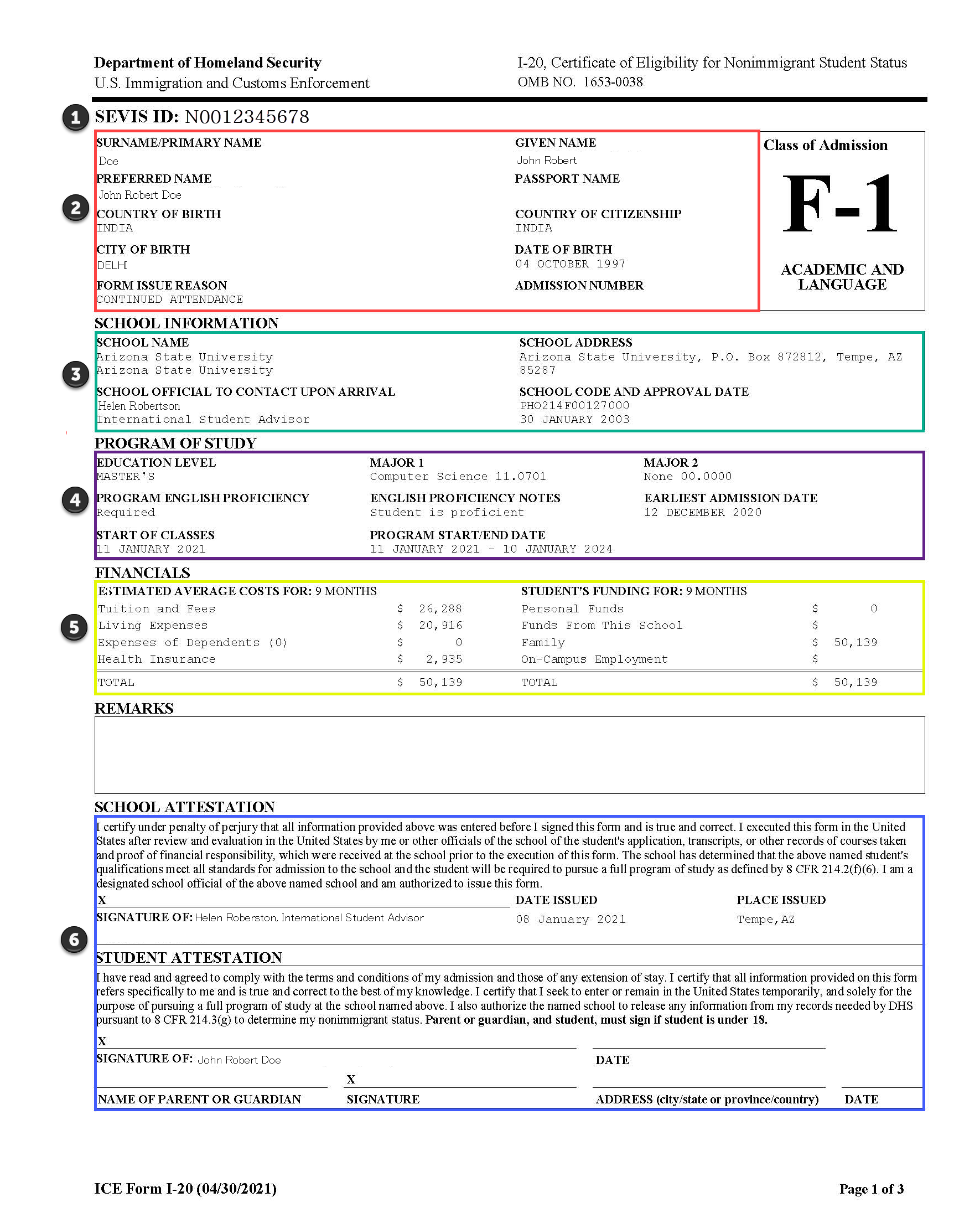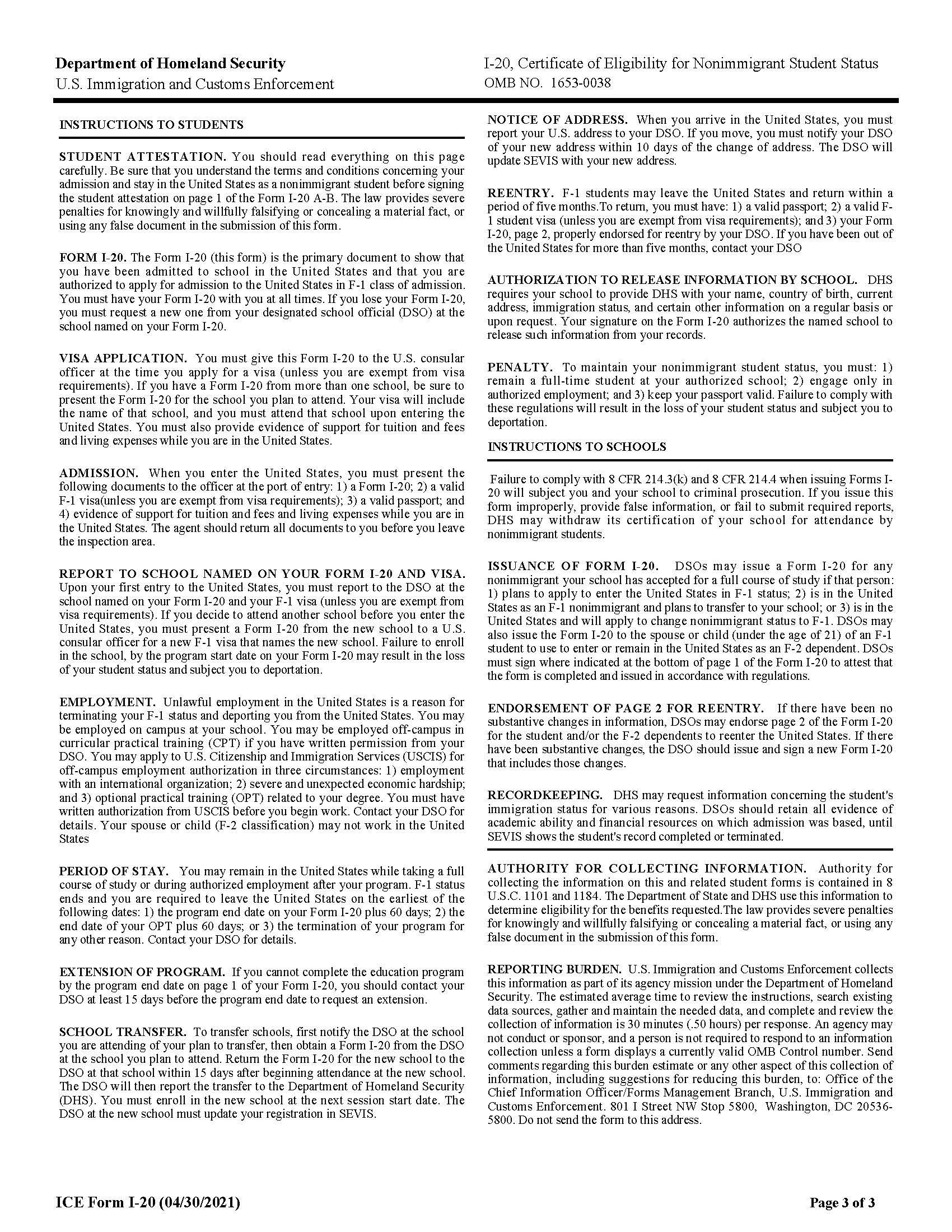The Form I-20 is the primary document to show that you have been admitted to school in the United States and that you are authorized to apply for admission to the United States in F-1 class of admission. You must have your Form I-20 with you at all times. If you lose or damage your Form I-20, you must request a replacement from the ISSC.
If any information included on the I-20 changes at any time, the student is required to obtain an updated version of the form by requesting a replacement from the ISSC.
Form I-20- Page 1

1. SEVIS ID Number
This number is provided by the Student and Exchange Visitor Information System (SEVIS) when an international student receives their initial I-20 to enter the United States. The number typically begins with N00 and can be found on the top of your I-20.
Students will need to activate their F-1 status by paying the I-901 SEVIS fee and then entering the United States with this I-20.
Generally, students keep the same SEVIS ID throughout their studies, however certain scenarios may cause this number to change. If your record is closed or your studies are interrupted, you may be issued a new SEVIS ID .
2. Biographical Information
This section includes your name, date of birth and citizenship information. You must read your I-20 carefully to make sure all information is correct. Please note that not all fields in this section will be completed. Some are left intentionally blank and will not affect your immigration status or ability to travel. The name on your I-20 should match your name as is listed on your passport. If you see an error, please contact us for assistance.
Additionally, this section displays the type of I-20 that has been provided to the student under"Form Issue Reason".
| Form Issue Reason | Explanation |
| Initial Attendance | This is your first, “initial” I-20 that you receive upon admission to a university. This I-20 can only be used once to enter the U.S. and will not include a travel signature. Students with this form issue reason MUST complete SEVIS New Student Check-In upon arrival to the U.S. in order to maintain F-1 visa compliance and receive the required “Continued Attendance” I-20. |
|
Transfer Pending |
If you transferred your SEVIS record from another U.S. institution including Global Launch, you will receive a Transfer Pending I-20 from ASU. Similar to the initial attendance I-20, this I-20 can only be used once to enter the U.S. and will not include a travel signature. Students with this form issue reason MUST complete SEVIS New Student Check-In upon arrival to the U.S. in order to maintain F-1 visa compliance and receive the required “Continued Attendance” I-20.
|
|
Continued Attendance |
This type of I-20 is issued to students when they need a travel signature. You can submit the Replacement and Travel I-20 eForm through the ISSC eForm Portal and you will be issued an I-20 that includes a travel signature on the second page (valid for one year). This will allow you to travel in and out of the U.S. |
3. School Information
This section contains information about the institution you have chosen to attend including the school name, address, and school official (DSO)*.
*There are several DSOs here to support students at ASU. Students do not need to contact the specific advisor who signed their I-20.
Additionally, this section includes the school code which is used to verify the institution.
4. Program of Study
This section includes important information regarding your level of education (bachelor's, master's, doctorate), major and corresponding CIP code, and program start and end date. If your major or level of education changes at any time, you must contact the ISSC to update your I-20.
What is a CIP code?
The U.S. Department of Education designates a six-digit code for your major at ASU. This Classification of Instructional Program (CIP) code is defined by the U.S. government. Sometimes, the CIP code name is different from your ASU major name because the CIP codes categorize majors at universities across the entire United States. For example, CIP code 30.3801 is used for the ASU degree 'Earth & Environmental Studies'. However, on your Form I-20, it will show under the CIP code name of 'Earth Systems Science'. If you believe there is a discrepancy, please contact the ISSC.
From Study in the States:
" Schools throughout the United States and its territories offer thousands of similar programs of study, but each have their unique program names and descriptions. The U.S. Department of Education (ED), which collects and reports data about these programs of study, developed the classification of instructional programs (CIP) to:
-
Map those programs to a shared understanding of what a given program of study includes.
-
Collect data from schools on programs of study offered.
-
Create reports on educational trends for use by government and the public.
The CIP’s comprehensive list of programs are broken into related categories. Each program has a name and an individual code.
The National Center for Education Statistics (NCES), a unit in the ED, manages both the CIP and the Integrated Postsecondary Education Data System (IPEDS), the database that collects and tracks data on postsecondary programs of study. Every ten years, NCES updates the CIP to add, remove, and revise programs that reflect changing fields of study. NCES last updated the CIP in 2010. "
5. Financial
This section includes important information regarding the cost of your program and your available funding. When admitted to ASU, international students must show proof of funding for one full year of tuition, health insurance and living expenses. Your financial information will not be updated after it is issued even if your funding sources change while completing your degree.
6. School Attestation
This section of the I-20 is required for validation of the document. The Designated School Official (DSO) who created the document must sign* to verify that the student is attending the institution and maintaining their visa status.
*Due to new COVID-19 guidance from SEVP, the ISSC will temporarily be sending I-20s to students electronically to their email addresses as listed in SEVIS.
The remarks section is an optional field that may contain important information regarding your I-20.
Once you have reviewed and verified all the information on your I-20, you MUST print the document and sign the "Student Attestation" section in blue ink to validate the document for use.


